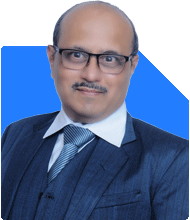Ramalingam Kalirajan |10314 Answers |Ask -Follow
Mutual Funds, Financial Planning Expert - Answered on Jun 21, 2025
He has an MBA in finance from the University of Madras and is a certified financial planner.
He is the director and chief financial planner at Holistic Investment, a Chennai-based firm that offers financial planning and wealth management advice.... more

Which one of them is best for long term saving for 10 years SIP, Mutual fund or fixed deposit in Bank?
Ask this simple question first—why are you saving for 10 years?
Is it for your child’s future?
Is it for your retirement gap?
Is it for home loan part-payment?
Is it just for wealth growth?
Your goal gives direction to your saving method.
Don’t choose saving tools without purpose clarity.
Difference in Wealth Growth Potential
Mutual fund SIPs create more wealth over 10 years.
Bank fixed deposits offer fixed interest but poor inflation adjustment.
In a 10-year view, inflation eats FD returns easily.
Mutual funds have potential to beat inflation consistently.
They offer compounding with market-linked growth.
Over 10 years, equity mutual funds show real wealth growth.
FD Returns Remain Flat Every Year
FD returns are fixed and predictable.
But they do not grow with time.
If you get 6% interest, it stays 6% for 10 years.
There is no bonus for loyalty or compounding gains.
You lose more to inflation every year.
For long-term goals, this erodes actual value.
Mutual Funds Grow with Market and Time
Mutual fund SIPs benefit from market cycles.
You buy more units when market dips.
You build real compounding with regular investing.
Even if market falls, SIPs average your cost.
Over 10 years, the chance of capital loss becomes very low.
SIPs reward patience with long-term wealth creation.
Taxation Works Better in Mutual Funds
This is a very important deciding factor.
In mutual funds:
Long-term capital gains above Rs 1.25 lakh is taxed at 12.5%.
Short-term capital gains are taxed at 20%.
In fixed deposits:
Interest is taxed every year as per your income slab.
So, if you are in 30% tax bracket, you lose more in FDs.
FDs give no indexation, no long-term benefit, no tax deferral.
Mutual funds allow you to postpone tax until withdrawal.
So they win clearly on tax front.
Flexibility and Liquidity Are Higher in SIPs
FDs charge penalty if withdrawn early.
They offer limited liquidity without breaking the deposit.
Mutual funds are open-ended and flexible.
You can pause, increase, or redeem when needed.
Partial redemption is also possible in mutual funds.
You stay in control always.
FDs don’t allow dynamic planning after investment.
You Can Customise SIPs for Goals
In mutual funds, you can select different types for each goal.
For example:
Use Flexi-cap fund for child education
Use Mid-cap fund for long-term growth
Use Hybrid fund for safety with growth
This customisation is not possible in FDs.
FD is one-size-fits-all tool, good only for parking idle money.
SIPs Support Emotional Discipline Over 10 Years
SIP method builds financial discipline.
You commit a fixed amount every month.
This automates your savings.
In FDs, you save only when you have surplus.
There is no force to continue saving.
SIPs force you to commit monthly—this builds strong financial habits.
FDs May Be Useful for Emergency or Senior Citizens
Bank FDs are suitable for only few cases:
If you are a senior citizen and want regular income
If you need emergency parking for 6–12 months
If your money must stay completely risk-free short-term
But for 10 years, this argument does not work.
You must beat inflation, not just preserve capital.
Long-Term SIPs Should Be Done Only Through Regular Plans
Many people choose direct funds from apps.
This is risky and emotionally unstable.
Disadvantages of direct funds:
No advice during market fall
Wrong scheme selection without risk profiling
Lack of exit strategy or tax planning
Portfolio becomes unbalanced over time
Instead, choose regular funds via a CFP and MFD.
You get proper guidance, tax help, rebalancing, and maturity tracking.
You will never invest emotionally or exit in panic.
Avoid Index Funds for Long-Term SIPs
Index funds are often promoted as low-cost tools.
But for Indian retail investors, they are not ideal.
Disadvantages of index funds:
No downside protection during market fall
They follow index blindly without quality filtering
You may lose years in sideways markets
They don’t adapt to economic shifts or sector rotation
On the other hand, actively managed funds give better risk-adjusted returns.
Fund managers select good stocks and avoid poor ones.
You get higher potential return for same risk.
In long-term, active funds build more wealth.
Especially when guided by a Certified Financial Planner.
Don’t Choose FD Just for Safety
Yes, FDs feel emotionally safe.
But over 10 years, their safety comes with hidden loss.
That hidden loss is inflation erosion.
If inflation is 6% and FD gives 6.5%, your real gain is near zero.
Also, tax further reduces your post-tax return.
So don’t chase safety by avoiding growth.
Growth with risk management is more powerful.
If You Are Scared of Market, Start with Hybrid SIP
If you are very new to mutual funds, start small.
Use hybrid funds with monthly SIP.
Over 1–2 years, increase amount as you gain confidence.
A CFP will help you choose right fund mix.
Don’t worry about short-term ups and downs.
In 10 years, volatility becomes your friend.
It helps you buy more at lower cost.
Do Not Stop SIP Midway
The real power of SIP is seen after 7 years.
Don’t stop after 3–4 years.
You will feel SIP is not growing initially.
That’s normal.
But later, growth becomes faster due to compounding.
Be patient.
Trust the long-term process.
SIP is like planting a tree, not a fast-food order.
SIPs Have No Penalty or Lock-In
Unlike FDs, there is no lock-in in SIPs.
You can pause anytime if needed.
You can also redeem without penalty.
This gives emotional comfort.
Even during income drop, you can reduce SIP, not stop completely.
This flexibility is very useful for salaried families.
Rebalance Your SIP Portfolio Every Year
Once SIPs run for 12–15 months, do annual review.
A CFP will check for:
Fund overlap
Underperformance
Market cycle adjustment
Tax harvesting opportunity
This keeps your SIP portfolio healthy.
FDs don’t need review but don’t grow either.
So yearly review makes SIPs sharper over 10 years.
Add Emergency Fund Outside SIP or FD
Along with SIPs, also build an emergency fund.
Use liquid mutual funds or short-term debt funds.
This protects your SIPs from being broken in urgency.
FDs can be broken but with penalty.
Mutual funds give better liquidity with smart tax handling.
A CFP will guide emergency fund plan as well.
Finally
For 10-year saving, SIPs in mutual funds are clearly superior.
FDs are static, low-growth, tax-heavy, and don’t beat inflation.
SIPs are dynamic, tax-friendly, and build real wealth.
They create good habits and long-term discipline.
Avoid direct and index funds.
Choose regular mutual funds through a CFP and MFD.
Start with small SIP.
Increase every year.
Stay invested without panic.
Do regular reviews.
10 years later, you will have peace of mind and real financial strength.
Best Regards,
K. Ramalingam, MBA, CFP,
Chief Financial Planner,
www.holisticinvestment.in
https://www.youtube.com/@HolisticInvestment
You may like to see similar questions and answers below
Ramalingam Kalirajan |10314 Answers |Ask -Follow
Mutual Funds, Financial Planning Expert - Answered on Apr 10, 2024
Ramalingam Kalirajan |10314 Answers |Ask -Follow
Mutual Funds, Financial Planning Expert - Answered on Apr 23, 2024
Nitin Narkhede |98 Answers |Ask -Follow
MF, PF Expert - Answered on Sep 09, 2024
Ramalingam Kalirajan |10314 Answers |Ask -Follow
Mutual Funds, Financial Planning Expert - Answered on Sep 22, 2024
Ramalingam Kalirajan |10314 Answers |Ask -Follow
Mutual Funds, Financial Planning Expert - Answered on Oct 16, 2024
Radheshyam Zanwar |6478 Answers |Ask -Follow
MHT-CET, IIT-JEE, NEET-UG Expert - Answered on Aug 21, 2025
Radheshyam Zanwar |6478 Answers |Ask -Follow
MHT-CET, IIT-JEE, NEET-UG Expert - Answered on Aug 21, 2025
Radheshyam Zanwar |6478 Answers |Ask -Follow
MHT-CET, IIT-JEE, NEET-UG Expert - Answered on Aug 21, 2025
Radheshyam Zanwar |6478 Answers |Ask -Follow
MHT-CET, IIT-JEE, NEET-UG Expert - Answered on Aug 21, 2025
Radheshyam Zanwar |6478 Answers |Ask -Follow
MHT-CET, IIT-JEE, NEET-UG Expert - Answered on Aug 21, 2025
Radheshyam Zanwar |6478 Answers |Ask -Follow
MHT-CET, IIT-JEE, NEET-UG Expert - Answered on Aug 21, 2025
Radheshyam Zanwar |6478 Answers |Ask -Follow
MHT-CET, IIT-JEE, NEET-UG Expert - Answered on Aug 21, 2025
Ravi Mittal |639 Answers |Ask -Follow
Dating, Relationships Expert - Answered on Aug 21, 2025
Nayagam P P |10446 Answers |Ask -Follow
Career Counsellor - Answered on Aug 21, 2025
Nayagam P P |10446 Answers |Ask -Follow
Career Counsellor - Answered on Aug 21, 2025
























